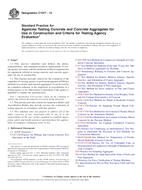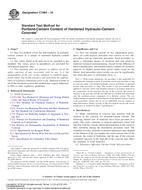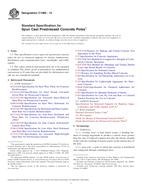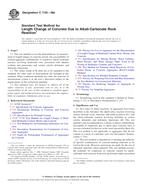We need your consent to use the individual data so that you can see information about your interests, among other things. Click "OK" to give your consent.
ASTM D4787-13
Standard Practice for Continuity Verification of Liquid or Sheet Linings Applied to Concrete Substrates
STANDARD published on 1.2.2013
The information about the standard:
Designation standards: ASTM D4787-13
Note: WITHDRAWN
Publication date standards: 1.2.2013
SKU: NS-28564
The number of pages: 5
Approximate weight : 15 g (0.03 lbs)
Country: American technical standard
Category: Technical standards ASTM
The category - similar standards:
Annotation of standard text ASTM D4787-13 :
Keywords:
conductive underlayment, conductivity, discontinuities, high voltage spark testers, low voltage wet sponge testers, ICS Number Code 91.100.30 (Concrete and concrete products)
Additional information
| Significance and Use | ||||
|
5.1 The electrical conductivity of concrete is primarily influenced by the presence of moisture. Other factors, which affect the electrical continuity of concrete structures, include the following: 5.1.1 Presence of metal rebars, 5.1.2 Cement content and type, 5.1.3 Aggregate types, 5.1.4 Admixtures, 5.1.5 Porosity within the concrete, 5.1.6 Above or below grade elevation, 5.1.7 Indoor or outdoor location, 5.1.8 Temperature and humidity, and 5.1.9 Age of concrete. 5.2 The electrical conductivity of concrete itself may be successfully used for high-voltage continuity testing of linings applied directly with no specific conductive underlayment installed. However, the voltage required to find a discontinuity may vary greatly from point to point on the structure. This variance may reduce the test reliability. 5.3 Although the most common conductive underlayments are liquid primers applied by trowel, roller, or spray, and which contain carbon or graphite fillers, others may take the form of the following: 5.3.1 Sheet-applied graphite veils, 5.3.2 Conductive polymers, 5.3.3 Conductive graphite fibers, 5.3.4 Conductive metallic fibers, and 5.3.5 Conductive metallic screening. 5.4 Liquid-applied conductive underlayments may be desirable as they can serve to address imperfections in the concrete surface and provide a better base for which to apply the lining. 5.5 This practice is intended for use only with new linings applied to concrete substrates. Inspecting a lining previously exposed to an immersion condition could result in damaging the lining or produce an erroneous detection of discontinuities due to permeation or moisture absorption of the lining. Deposits may also be present on the surface causing telegraphing. The use of a high voltage tester on a previously exposed lining is not recommended because of possible spark through which will damage an otherwise sound lining. A low voltage tester can be used but could produce erroneous readings. 5.6 The user may consider this practice when performance requirements of the lining in a specified chemical environment require assurance of a lining free of discontinuities. 5.7 Factors affecting the dielectric properties and test voltage shall be considered. Some factors are the curing time of liquid-applied linings; the possible presence of electrically conductive fillers or solvents, or both; the possible presence of air inclusions or voids; and the compatibility of conductive underlayments with the specified lining. 5.8 A pulsed dc high voltage may cause a lining to breakdown at a lower voltage than would be the case for a continuous dc voltage. |
||||
| 1. Scope | ||||
|
1.1 This practice covers procedures that may be used to allow the detection of discontinuities in nonconductive linings or other non-conductive coatings applied to concrete substrates. 1.2 Discontinuities may include pinholes, internal voids, holidays, cracks, and conductive inclusions. 1.3 This practice describes detection of discontinuities utilizing a high voltage spark tester using either pulsed or continuous dc voltage. 1.4 This practice describes
procedures both with and without the use of a conductive
underlayment.
1.5 The values stated in SI units are to be regarded as standard. The values given in parentheses are for information only. 1.6 This standard does not
purport to address all of the safety concerns, if any, associated
with its use. It is the responsibility of the user of this standard
to establish appropriate safety and health practices and determine
the applicability of regulatory limitations prior to use.
Standard Practice for Discontinuity
(Holiday) Testing of Nonconductive Protective Coating on Metallic
Substrates Standard Test Methods for Holiday
Detection of Coatings used to Protect Pipelines |
Similar standards:
Historical
1.12.2012
Historical
15.6.2011
Historical
1.2.2014
Historical
1.4.2010
Historical
1.1.2013
Historical
1.12.2008
We recommend:
Technical standards updating
Do you want to make sure you use only the valid technical standards?
We can offer you a solution which will provide you a monthly overview concerning the updating of standards which you use.
Would you like to know more? Look at this page.



 ASTM C1064/C1064M-12..
ASTM C1064/C1064M-12.. ASTM C1074-11
ASTM C1074-11 ASTM C1077-14
ASTM C1077-14 ASTM C1084-10
ASTM C1084-10 ASTM C1089-13
ASTM C1089-13 ASTM C1105-08a
ASTM C1105-08a
 Cookies
Cookies
